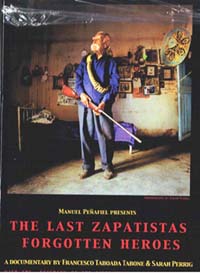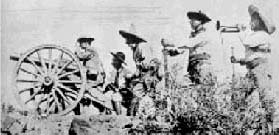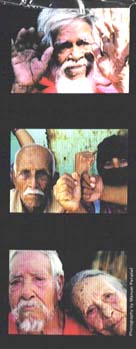Forgotten Heroes: Zapata and the Struggle for Land
By Roy Cook
 |
Saturday, November 16, 2002, in the Worldbeat Center, Balboa Park, Tim Redbird, Kiowa and the Red Warrior Drum opened the special showing of the documentary film, Forgotten Heroes. This Red Warrior Southern Plains drum sang appropriate Warriors songs for the Heroes of this struggle to protect the land for the people. This extraordinary film is a bit long at 75 minutes but emotionally powerful and respectfully filmed by Francesco Taboada Tabone. Emiliano Zapata and the Mexican Revolution has cult status in the Northern American Hemisphere. The Worldbeat Center in Balboa Park continues to set the standard for cross cultural experiences. Consistently events are presented of real quality and real people. There were people from all the continents in attendance, many have tribal roots. Evans Craig, Dine and Steve Rouillard, Dakota remarked on the visible improvements of the center. There is a new Art gallery and construction is evidently in progress for some new office space. |
Zapatistas, literally and symbolically were the main focus
of the film.
| Historically the Mexican revolution is mostly overlooked in U. S. mainline education systems. Lets review this American History. During the decade of armed revolution (1910-20) the United States mounted two major and one minor armed incursions into Mexican territory: The Marines seized the port of Veracruz in April 1914; General Pershing led a sizable expedition deep into northern Mexico, fruitlessly pursuing Pancho Villa (1916-17); and American forces helped dislodge the ragtag Villista army from Ciudad Jua'rez in June 1919. |  |
In the book: Revolutionary Mexico, The Coming and Process of the Mexican
Revolution, Hart described how the United States during the Mexican Revolution
helped the ruling government by stockpiling weapons in Veracruz warehouses.
Noteworthy for historians of communications technology and warfare, equipment
from the United States sent to Veracruz included 'radio transmitters'
and 'shortwave radio sets.' (Hart 1989, 301,302) This was when the use
of radio in warfare was still being developed. Voice transmission only
became practical 8 years before in 1906.
The U.S. American intervention at Veracruz in April 1914 constituted the
focal point of the U.S. government's effort to control events in Mexico.
The U.S. Americans controlled an immense strategic stockpile of arms there.
The military equipage included over 4,500 crates of armaments and filled
three warehouses to overflowing, each of which measured 57.5 yards in
width and length and over 21 feet in height. More arms including machine
guns and artillery were placed in reinforced depositories, among them
the Baluarte of Veracruz, the Benito Juarez lighthouse, and the San Juan
de Ulloa fortress.
After the Pershing expedition (1916-1917) in which 12,000 U.S. soldiers
sought small groups of Villistas, U.S. troops entered Mexico, without
declaration of war, at least three times in 1918 and six in 1919. In August
1918 American and Mexican troops fought at Nogales.
 |
In the film by Francesco Taboada many elderly veterans
of the Mexican revolution, who had served with Emiliano Zapata, were
interviewed. During this time, several other Mexican folk heroes began
to emerge, including the well known Pancho Villa in the north, and
the peasant Emiliano Zapata in the south, who were able to harass
the Mexican army and wrest control of their respective regions. Fransisco
Madero was elected president, but received opposition from Emiliano
Zapata who didn't wish to wait for the orderly implementation of Madero's
desired land reforms. In November of the same year Zapata denounced Madero as president and took the position for himself. He controlled the state of Morelos, where he chased out the estate owners and divided their lands to the peasants. Later, in 1919, Zapata was assassinated by Jesus Guajardo acting under orders from General Pablo Gonzalez. In the film these Mexican revolution veterans told their struggle to survive the aftermath of the assassination of Zapata and the broken promises to the people of the land. With brave hearts, "Mucho Corazon." they demonstrated they were armed and still ready to fight for liberty, justice, and land for the people. |
Following the film and the warm reception of the audience the film maker
Francesco Taboada entertained questions and offer further insights as
to the participants, the drama of the filming experience and current political
events in Mexico and how they are related to portions of the film and
to U. S. involvement. Described in the talk are the events in and around
San Cristobal de las Casas, Chiapas, the center of the Zapatista uprising.
The Zapatista Army for National Liberation, the EZLN just moments after
midnight on January 1, 1994.
In addition to occupying the municipal building in the main square of
San Cristobal, EZLN forces occupied the surrounding communities of Las
Margaritas, Altamirano, Ocosingo, Oxchuc, and Huixta'n. The Mexican military
responded slowly at first, as they were caught off guard. But by January
12 EZLN combatants had retreated to positions in the jungle to the east
of San Cristobal and President Salinas had declared a cease-fire. The
12-day war demonstrated the air war capabilities of the Mexican Air Force,
which came under heavy criticism for targeting civilian communities. Also
brought into question were helicopters supposedly only for anti-drug use.
The helicopters in the military's fleet were the building blocks of the air campaign. Drug war largess had given Mexico the wherewithal to purchase over 100 HUEYS and Bell 212s. 82 choppers in the fleet are under military control and at least 22 more are leased to Mexico for a nominal fee and fall under the purview of the federal prosecutor's office for exclusive use in anti-narcotics raids. There is little doubt that U.S. aircraft was used by the Mexican military to wage war on the Indians of Chiapas.
There has been a cool reception to this Francesco Taboada film by the Mexican government.
Finally, Tim Redbird and the singers sang Veterans songs, memorial songs, and horse stealing songs. All the singers enjoyed the hospitality and courtesy shown to them.